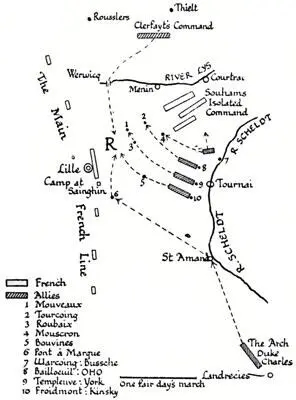As I have said, it was at the end of April that this false success of Pichegru’s was achieved, and a whole fortnight was to elapse before the allies concentrated to take advantage of that error, and to cut off Souham’s division.
That fortnight was full of minor actions, not a few of them interesting to the student of military history, and one again remarkable as a feat of English horse. I deliberately omit all mention of these lest I should confuse the reader and disturb his conception of the great battle that was to follow.
That battle proceeded upon a certain plan thought out in detail, perfectly simple in character, and united in conception. It failed, as we shall see; and by its failure turned what should have been the cutting-off and destruction of Souham’s command into a signal French victory. But before we can understand the causes of its failure, we must grasp the plan itself in its major lines, and with that object I shall discuss it in my next section under the title of “The Plan of the Allies.”
PART III
THE PLAN OF THE ALLIES
Table of Contents
If the reader will look at the map opposite he will see in what disposition the armies of the allies were, at the end of April and the first days of May 1794, to carry into effect the plan which I proceed to describe.
There, in its triangle or advanced wedge, with a base stretching across Lille and an apex at Courtrai, lay the exposed French division, Souham’s.
Clerfayt was to the north of that wedge. The French, in pushing their wedge up to Courtrai, had thus separated him from the rest of the allies. Clerfayt lay with his command round about the district of Roulers; he attempted to return and oust Souham, but he failed, and to the north of the French wedge, and separated from the rest of the allies by its intervening thousands, he remained up to, throughout, and after the great battle that was to follow.

Right away down south, nearly sixty miles as the crow flies, lay the bulk of the Austrian army, Coburg’s command, round the town which it had just captured, Landrecies. The Duke of York’s command, detached from this main army of Coburg, had been ordered north, and was, by May 3rd, at Tournai. To the east lay the Prussian forces together with a small body of Hanoverians, about 4000 in number, which last could be brought up on to the Scheldt River when necessary.
It will thus be seen that the allies, at the moment when the plan was about to be formulated, lay on either side of the French wedge, and that any scheme for cutting off that wedge from the main French line must consist in causing a great force of the allies to appear rapidly and unexpectedly between Courtrai and Lille.
In order to do this, it was necessary to get Clerfayt to march down south to some point where he could cross the River Lys, while the rest of the allies were marching north from their southern positions to join hands with him.
When this larger mass of the allies coming up from the south and the east should have joined hands with Clerfayt, all the great French body lying advanced in the valley of the Lys round Menin and Courtrai would be cut off.
Now the success of such a plan obviously depended upon two factors: synchrony and surprise. That is, its success depended upon the accurate keeping of a time-table, and upon carrying it out too quickly and unexpectedly for Souham to fall back in time.
Clerfayt’s force coming down from the north, all the rest of the allies coming up from the east and the south must march with the common object of reaching “R,” a fixed rendezvous, agreed upon beforehand, and of meeting there together at some appointed time. If any considerable body lagged behind the rest, if part of the great force marching up from the south, for instance, failed to keep in line with the general advance, or if Clerfayt bungled or delayed, the junction would be imperfect or might even not take place at all, and the number of men present to cut off the French when a partial and imperfect junction had been effected, might be too small to maintain itself astraddle of the French communications, and to prevent the great French force from breaking its way through back to Lille.
So much for synchrony: and as for surprise, it is obvious that for the success of this plan it was necessary to work both rapidly and secretly.
Here was Souham with a body of men which recent reinforcement had raised to some 40,000, lying much too far ahead of the general French line and in peril of being cut off. Pichegru was foolish to maintain him in that advanced position, but, though that was an error, it was an error based upon a certain amount of calculation. Pichegru, and Souham under his orders, kept to their perilous position round Courtrai, because it did after all cut the allies in two, and because they knew that they could deal with Clerfayt’s force upon the north (which was only half their own), while they also knew that the bulk of their enemies were tied down, far away to the south, by the operations round Landrecies.
If Souham at Courtrai got news in time of the march northward of that main southern force, he had only to fall back upon Lille to be saved.
It was not until the 10th of May that the plan was elaborated whereby it was hoped to annihilate Souham’s command, and this plan seems to have occurred first to the Duke of York upon the evening of that day, after a successful minor action between his troops and the French just outside Tournai.
The Duke of York had been at Tournai a week, having come up there from Landrecies after the fall of that fortress, though the mass of the Austrian forces still remained away in the south. The week had been spent in “feeling” the south-eastern front of the French advanced “wedge,” and it was by the evening of the 10th that the Duke of York appears to have decided that the time was ripe for a general movement.
At any rate, it was upon the morrow, the 11th, that the English Prince sent word to Clerfayt that he intended to submit to the Emperor, who was the ultimate authority upon the side of the allies, a plan for the general and decisive action he desired to bring about. On the next day, the 12th, a Monday, the Duke of York wrote to Clerfayt that he hoped, “on the day after the morrow” (that is, upon the Wednesday, the 14th), “to take a decisive movement against the enemy.” And we may presume that the Duke had communicated to the Emperor the nature of his plan. For on the 13th, the Tuesday, the Emperor was in possession of it, and his orders, sent out upon that day, set out the plan in detail. 1That plan was as follows:—
Clerfayt, with his force, which was rather less than 20,000 all told, was to march south from Thielt, his headquarters for the moment, and advance upon the little town of Wervicq upon the River Lys. Here there was a bridge, and Clerfayt was also in possession of pontoons wherewith to pass the stream. Meanwhile, the southern mass of the allies was to concentrate upon the Scheldt in the following manner:
The few thousand Hanoverians, under Bussche, were to take up their position at Warcoing, just upon and across that river. Two miles further south, Otto, with a larger Austrian force accompanied by certain English cavalry (the numbers will follow), was to concentrate at Bailleul.
The Duke of York’s own large force, which had been at Tournai for over a week, was to go forward a little and concentrate at Templeuve. Five miles to the south of Templeuve, at Froidmont, a column, somewhat larger than the Duke of York’s, under Kinsky, was to concentrate.
There were thus to be concentrated upon the south of the French wedge four separate bodies under orders to advance northward together.
Читать дальше













